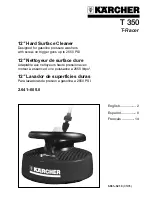
12
If there are any problems, you must address these before proceeding with normal use. The
washer will automatically turn off at the end of the cycle if there are no problems.
If the washer is moved or tipped for any reason, it must be completely re-installed
following the steps in this installation guide. This includes running a test cycle to check for
any problems.
*Your washer control panel may differ from that shown.
4
Wait until you see water in the bottom of
the drum.
Press
to stop the cycle, then press
POWER
to turn the washer off.
Activate the washer again by pressing
POWER
, select
SPIN
cycle.
Press
to begin the spin.
Check the drain hose is firmly secured to the
standpipe or tub, or spigot.
Observe that the washer pumps out the
water, and spins.
The washer will beep to signal the end of
the cycle. Any faults will be displayed on the
screen, refer your user guide.
5
6
INSTALLER CHECKLIST
TO BE COMPLETED BY THE INSTALLER
Have the packaging and transit bolts and rods been removed?
Is the washer correctly levelled, feet are extended and cabinet corners are clear of
the floor?
Is the drain hose threaded through the hose guide ‘U bend’ (with no more than 20mm
extended) and hooked into your standpipe or tub, or attached to a spigot?
Have the taps been turned on?
Is the hot hose connected to the hot valve marked ‘H’?
Is the cold hose connected to the cold valve marked ‘C’?
Has the power cord been connected to an appropriate power supply and the power
turned on?
Have you performed the test cycle?.
Complete a
DRUM CLEAN
cycle with a half-load amount of detergent and without a load
to remove any residues remaining in the washer from the manufacturing process.
Complete and keep for safe reference:
Model
Serial no.
Purchase date
Purchaser
Dealer address
Installer’s name
Installer’s signature
Installation company
Installation date
COMPLETE INSTALLATION


































